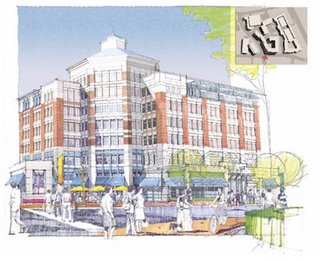This ain’t your father’s Fairfax County. KSI Services Inc., of Vienna, has received the OK from the Fairfax County Board of Supervisors to build 152,400 square feet of offices (with an option to add 50,000 square feet more), 32,100 square feet of retail and 500 residential units onto a scant 18 acres. The urban, mixed-use project stands on property that previously had been zoned industrial, permitting no residential at all, according to an article in the Connection newspapers.
From my distant vantage point here in Richmond, it looks like a winning formula: Give developers permission to increase density… which increases the revenue flow from the project… which allows the developer to provide public infrastructure such as, in this case, parking, quality open space and the extension of the four-laned, median-divided Government Center Parkway.
The Ridgewood project at the intersection of Waples Mill Road and Lee Highway will have a New Urbanism feel: ground-level retail in multi-story buildings otherwise dedicated to apartments, condos and offices… parking tucked underground… pedestrian-friendly design of the streetscapes… housing designed for households making less than $74,000 a year… and quality public spaces.
Plus, Ridgewood will offer a feature that’s quickly becoming all the rage in Fairfax County, a Traffic Demand Management (TDM) plan. The Connection article offers few specifics on the plan other than to say that “Ridgewood will … participate in a future shuttle-bus program.”
Many of the traffic demand features are baked into the project. A mixed-use project, by its very nature, creates an environment where people can conduct some of their routine errands and trips on foot. Also, because KSI has designed eight percent of the apartments/condos as “workforce” housing, dozens of teachers, police officers, clerks, tradesmen and other blue- and pink-collar workers can forego buying a house in Stafford/Spotsylvania counties and making the grueling, 50-mile commute on Interstate 95 every day.
Developers like KSI and Pulte Homes in Fairfax County are ahead of the curve. They’re designing transportation-efficient communities — not as the result of government fiat or social engineering but in response to market demand. Fairfax County, apparently, sees the wisdom in this kind of mixed-use development and is permitting departures from its outdated zoning code and comprehensive plan.
The Ridgewood project drives home, once again, that the ultimate, long-term solution to traffic congestion in Virginia lies not in widening our thoroughfares to 17 lanes but in revisioning the way we build our communities. This trend is real, folks, and let us hope that the General Assembly takes cognizance of it when it reconvenes later this year to discuss transporation solutions.


Leave a Reply
You must be logged in to post a comment.